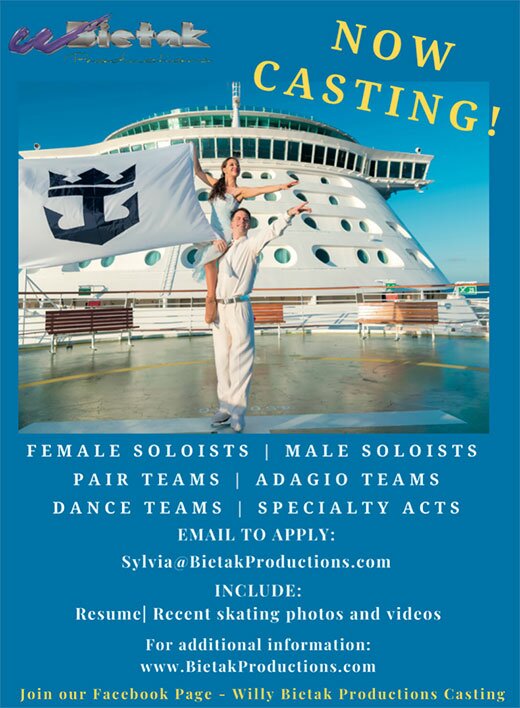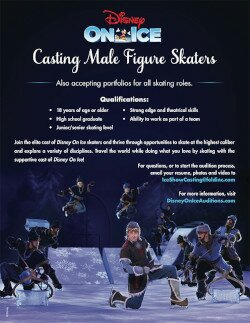Inspired by the greatest legends in ice dance, Great Britain’s Lilah Fear and Lewis Gibson are aiming to make their own unique mark in the world of figure skating.
Ask Lilah Fear and Lewis Gibson about their current direction in ice dance and they will take you back to a legendary former nightclub in New York City with an infamous past. Their free dance last season, which paid homage to Studio 54 and the disco era of the late 1970s, taught the British duo a thing or two about audience participation and their ability to make it all happen. It marked a turning point in how they are now approaching their still-burgeoning ice dance career.
As much as they are all about improving their skills and their standing among the world’s top teams, Fear and Gibson have embraced the idea of being crowd pleasers as well, and that is now a big part of who they are and what they want to present on the ice. “Doing disco turned out to be a lucky choice, and from there it completely redirected us to where we see ourselves going, what we feel is our style and what makes us unique,” said Fear, a 20-year-old from London. “We like to dance, and we really thrive on the crowd’s enjoyment as well. It’s something we’ve identified that we really want.
“We’re not saying we need all this attention. It just makes us feel like a part of something bigger to touch people. I know that sounds kind of cheesy, but when you see people enjoying what we do and you have little kids coming up to you afterward, it really means a lot.”
Fear and Gibson, who are coached by Romain Haguenauer at the Ice Academy of Montréal, now admit that straying away from more traditional styles of music for a free dance — and instead swaying along with disco queen Donna Summer — came with some trepidation. “The thing with last year’s disco program is that it was a bit of a risk,” said Gibson, 25, who hails from Prestwick, Scotland. “We had never done anything like that before, with that sort of speed and movement or even performance level. But, we went for it and it paid off big time. A big part of last season was the enjoyment level of skating that we had and it was something that we really wanted to bring to this season — the entertainment factor and the vibe we feel from the audience when we perform to that style of music.”
With that direction now firmly set in their minds, they are looking for even more this season. Though the music styles have changed — The Blues Brothers for the rhythm dance, the legendary Madonna for the free — the beat goes on in their hearts and in their performance level. Fear and Gibson won their first- ever Grand Prix medal, a bronze, at 2019 Skate Canada, and followed that up with a fourth-place finish at NHK Trophy (they ranked third in the free dance).
While they produced personal best scores across the board at Skate Canada, it was the chance to stand on the podium at a Grand Prix event that was cause for true celebration. It marked the first time the Union Jack had risen over a Grand Prix podium for a British ice dance team since 2014, when Penny Coomes and Nicholas Buckland claimed bronze at Rostelecom Cup in Moscow.
Fear and Gibson squeezed into the bronze-medal position by a scant 0.58 of a point over the American team of Kaitlin Hawayek and Jean-Luc Baker, who train alongside them in Montréal. It was high drama to be sure. “Shock. I burst into tears because I wasn’t expecting it in the slightest,” Fear recalled. “When you’re that surprised, it’s hard to really control your emotions. I managed to get it together and then it was just exciting, and it was an honor to stand on the podium and to see our flag … it was amazing.”
It was another positive sign, Gibson said, about the progress they are making this season. “It’s been really great that basically every event we’ve gone to, we’ve had a better score each time. And of course, that builds a lot of confidence because that’s not always the case. The season’s focus has been on trying to improve our skating skills and on being a stronger team together.”
They also see it as further validation for the music choices they have made in the wake of last season’s disco revelation. It was Gibson who proposed the idea of using the bodacious 1980s sounds of The Blues Brothers, with their rhythm dance featuring a trio of songs — “Soul Man,” “Everybody Needs Somebody To Love” and “Shake A Tail Feather.”
“I was researching music and I came across this song. And I thought, ‘I recognize this from somewhere,’” Gibson explained. “And when we learned that the rhythm dance music this year was from musicals, I thought, this is just fantastic.”
Fear had not seen the movie and did not know the Blues Brothers, but she knew all the songs. “We knew that could get the crowd on its feet, hopefully, and people would be tapping their toes. That’s something with disco that really helped last year, that people knew the songs.”
As for the free dance, which features Madonna’s “Vogue,” “Hung Up” and “Like A Prayer” … Fear points to her mother, Kirsten, an avid skater herself, for providing the inspiration. “When she was growing up, Madonna’s music was something that was so prominent. She’s such an icon. My mom brought that idea to us and after some thought, we were like ‘actually, that could work. Why not give it a go?’ You never know. It’s always a risk with these types of things, but we just hoped to bring the vision to life and that people would react the way we wanted them to.”
SURPRISE PAIRING
Every team has its own unique ‘how did they get together’ story, and Fear and Gibson are no different. It is reasonable to wonder how a guy from Scotland who started out playing soccer and a young lady who was born to Canadian parents while living in New York, managed to become ice dance partners.
Gibson, like many Scottish youngsters, was first enamored with what the world outside of North America refers to as football (soccer). Until, at age 11, he watched “Dancing On Ice,” a British television series that pairs figure skaters with celebrities. The hosts for the show, 1984 Olympic champions Jayne Torvill and Christopher Dean, are to this day absolute royalty in British ice dance. “I learned how to skate after watching that. That was my inspiration,” Gibson said.
A singles skater for five years, he won a few medals along the way. But there was one huge goal that Gibson had in mind and, as the men’s discipline rapidly evolved and the quad revolution took off, he knew he would not be able to keep up. For me, it was about the goal of competing at the Olympics — that’s something that I always had,” he said. “In singles skating, the quads were really becoming a thing a few years ago and now it is the thing. I didn’t see myself getting them, so I decided to try ice dance. I had been encouraged by the British federation many times to try it — they felt I had a strong feel for music and dance and kept pushing me in that direction.”
While Gibson was working his way toward becoming an ice dancer, Fear had been immersed in it for much of her life. She and her family moved to London when she was 2 years old and she began learning to skate at age 5. Eventually, she joined the solo dance program run by the British federation that helps skaters who aspire to be ice dancers.
Fear partnered with Jacob Payne for the 2013-2014 season, winning the British novice title. A year later, they were bronze medalists at the junior level. But by 2016, the partnership had run its course — which happened to coincide with Gibson’s decision to try his hand at ice dance. “I had seen Lewis before. The funny thing is, we had both trained at the Cricket Club in Toronto. Not together, but we had been there at the same time for a few summers,” Fear recalled.
When Gibson “put it out there” that he was looking for an ice dance partner, a tryout was arranged with Fear and a new partnership was born. “The timing was crazy,” she said.
The two brought different strengths to the table — Gibson was a natural dancer, while Fear carried the necessary musicality derived from her years in ice dance. The work ethic and drive they both share helped them build off each other’s best assets. While it may not have worked smoothly right away, they saw the potential fairly quickly. “Working together at the beginning is always a little awkward because you don’t know the person very well, unless you’re best friends,” said Fear. “For me, it was more when I saw the videos of our practice sessions. Even though it wasn’t great, I could see our bodies matched very well and our lines were actually pretty similar. That’s something that was a good indicator at the beginning.”
For the first two years of their partnership, they were coached by Karen Quinn at the Alexandra Palace Ice Rink in London, and Haguenauer in Montréal. But once Fear finished high school, they made the move to Canada permanently. “I’ve known Romain since I was maybe 10 years old. He choreographed for my solo dance career and when he was still living in France, we would meet and he would do my choreography,” Fear explained. “When I started with Lewis, we came here at one point just to get some guidance and we really felt it was the right place to be.”
Added Gibson: “We’re very thankful he was willing to work with us from the beginning. I had been a singles skater and I had no clue about ice dancing. We have some video footage of that and it’s …
“Shocking,” Fear interjected with a laugh.
FRENCH MAGIC
The move to Montréal put them on the same ice as Haguenauer’s prize students, Gabriella Papadakis and Guillaume Cizeron, the four-time World champions from France. Also there and in pursuit of their second Olympic title were Canada’s Tessa Virtue and Scott Moir, who were Fear’s idols growing up.
“At the beginning, when we first arrived, we were very much deer in the headlights. We were star struck,” Fear recalled. “We were on the ice with Tessa and Scott the very first day we were there. But once we got settled and got to know these people — it’s just the most wonderful environment to train in because we’re all pushing each other. There’s competitive energy, but not in a negative way. We’re all trying to do our best and we’re all improving as a result of that.”
While they are nowhere near the class of Papadakis and Cizeron, Fear and Gibson feed off the opportunity to train alongside the French team. “What is really great is that you’re receiving corrections from the same coach,” said Gibson. “You see people work on certain things, and then you go out in a really competitive environment and all of sudden, it’s like, ‘Oh great, I’m a little bit further along.’ You get to compare yourself to them on a daily basis and it’s really helped us move forward a little faster.”
“Just to see how they work together, how they train, their work ethic…it’s amazing to be exposed to that so directly, to people you look up to, and to literally be sharing the ice with them,” Fear added. “That’s something so unique that we’re really lucky to have.”
The British team cannot help but feel the influence of the legendary Torvill and Dean — and it goes beyond the fact they unwittingly lured Gibson onto the ice in the first place. “Even if people in Britain don’t know what ice dance is, you just say Torvill and Dean and they get it,” said Fear. “They have been a huge influence on us and for so many skaters from Great Britain … they’re just iconic. We got to work with them one morning a couple of years ago at our rink in London. It was very interesting to see how they work together, and how creative they are.”
Gibson also has an affinity for his fellow Scots, Sinead Kerr and John Kerr, the seven-time British champions from 2004-2010 and two time Olympians who won a pair of bronze medals at the European Championships. “I was very lucky to be able to train with them some days in Edinburgh, when they would come back between competitions,” said Gibson. Looking back now, they were a very creative team. They always had cool ideas for programs and costumes. That’s something we have a similarity to, that creativeness.”
Fear and Gibson now have their own “cool programs” to show off, and they are enthused about the idea of doing it right in their own backyard at the 2020 World Championships in Montréal in March. Their parents will be on hand to watch, along with Fear’s younger sister, Sasha — a junior ice dancer who trains part of the year at their rink in Montréal with partner George Waddell — and other members of her extended family who live in Canada. “It’s super exciting. For us, it’s going to be the closest thing possible to being at home,” said Gibson.
It will also be a chance for the duo to show off their adopted city, which they have come to love. Fear, who also studies psychology part-time at McGill University, lives between the school and their training venue. Gibson is just a 15-minute walk away from the Gadbois Centre. In their eyes, Montréal is the ideal place to grow as skaters and as people. “I like the size of the city. It’s small (compared to London), so it’s really great to get around,” said Gibson. “There are so many different gyms and places where you’re able to work out.”
Outside of training, Fear said Montréal “is brilliant. There’s so much culture here, amazing restaurants. You can go for walks in the park. We never get bored.”
ON THE RISE
Last season, Fear and Gibson hit new heights at the European and World Championships, finishing sixth and 13th, respectively. They carried that momentum into the Grand Prix Series and while their early season results suggest more big things may be in store for them later this season, the British duo is doing their best not to get too far ahead of themselves. “We never really set outcome based goals. It’s better to stay present and do as much as you can in the moment and see where it takes you,” said Fear.
“For us, it’s just been surprise after surprise, and it’s kind of fun like that. The only thing that it changed is our confidence. Not in a bad way, but we need to hold ourselves to a higher standard now and maybe have more expectations in terms of what we can achieve. That’s just motivated us more to keep going in the direction we’ve been going.”
If all goes as they hope, that direction will take them all the way to the 2022 Olympic Winter Games in Beijing. Fear and Gibson got a taste of the Olympics in 2018 when they were taken to the Winter Games in PyeongChang as part of the Team GB Ambition program for potential future Olympians. Though there for less than a week, it fueled their desire to get to Beijing. “It’s something you can’t even imagine. We weren’t even competing, but just the energy … you could feel it,” Fear recalled.
“It was so exciting,” added Gibson. “We got to watch the short dance and the men’s short program. Just to be exposed to that, it really made us hungry to get there ourselves.”
(Ed. Note: Fear and Gibson finished fifth at the 2020 European Championships).
(Originally published in the IFS February 2020 issue)






